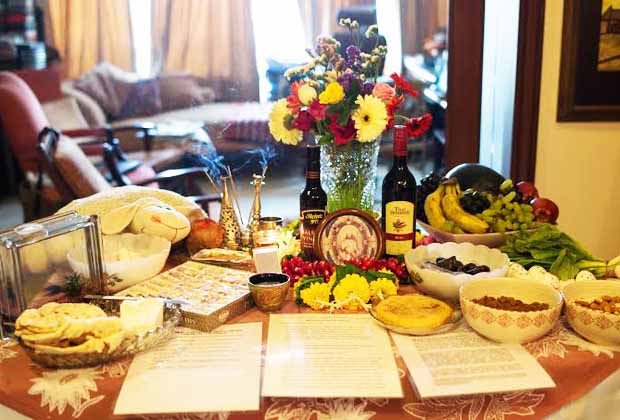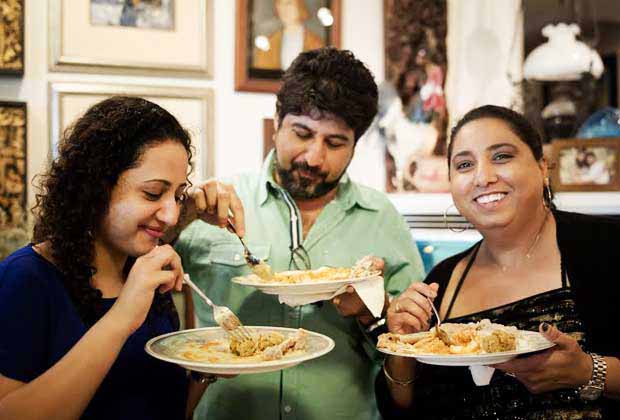Tales of the Parsi Haft Seen Table
- By Perzen PatelLoading...
- | 22 April 2015 4:22 PM IST
 X
X
 A Haft Seen Table typically comprises seven items
A Haft Seen Table typically comprises seven items
It’s been a while since Navroze has passed us by. The more-than-usual excitement over Parsi food is over, the pantry re-filled and the fridge is no longer bursting at its seams with endless packs of Lagan Nu Custard.
For the uninitiated, Navroze is the star calendar attraction for Parsis and Iranians globally.
Now celebrated as the beginning of spring, Navroze was the original Parsi New Year almost 1200 years ago when the Parsis who fled to India still resided in Iran.
While the festival continues to be celebrated the original way in Iran – a food fiesta spread across 13 days – for most Parsis in India it is now simply a day of celebration, of letting bygones be bygones and starting afresh!
And, of rejoicing with friends and family with platefuls of good food accompanied perhaps with a Parsi play in the evening. Which of course means that on Navroze, most Parsi caterers are busy stocking up on kilos of chicken, lamb and pomfret to ensure there’s enough meat to satiate everyone’s desires.
While the kitchens of more established caterers like Godiwala and Kurush Dalal of Katy’s Kitchen are filled with cooks cranking out those Patra ni Machchis, for younger caterers like yours truly – who is the only cook in her kitchen – it is time to burn the midnight oil and ensure that all her clients get fed on time.
Even if that means waking up at 3 AM to start cooking the fish for her signature Surmai Lagan no Patio.
All work and no play makes Bawi Bride a dull girl though, and so for the past two years, I’ve brought in Navroze by hosting a special Navroze pop-up.
While the one I did last year was for an intimate group of bloggers, this time I did one for a big group of 18 foodies and another for a group of young Zoroastrians, who were visiting India as part of a ‘Return to Roots’ initiative.
Having people over and feeding them till they are stuffed gives me a lot of joy.
However, the best part of these pop-ups is introducing my guests to the Navroze Haft Seen Table – an old Iranian tradition that in India is now only practiced by the Iranis, which is a group of Zoroastrians who migrated to India a few hundred years ago.
Given that I am 25% Irani, this is one tradition I take a lot of pride in!
 Happy faces gorging on treats from a Navroze Haft Seen Table
Happy faces gorging on treats from a Navroze Haft Seen Table
Haft Seen is a traditional table-setting done for Navroze, which comprises seven items beginning with the letter ‘S’ or ‘Sh’ in Persian.
Guests are invited to look into a mirror and smile at their reflection – symbolising the flow of positive energy – and are sprinkled with rose water to ensure that they ‘always remain sweet’.
After this, guests are encouraged to gorge on treats from the table including dry fruits, naan, paneer and the Iranian nougat-like sweet Gaz, which is then followed by lunch. You tell me, what’s not to like about such a food-filled custom?
So, if all the Parsi caterers are busy cooking and feeding Patra Ni Machchi, Pulao Dal or Kaju Chicken to everyone, what do they eat themselves?
Most of us go hungry during the day as we pump out those orders. But come evening, it’s time to celebrate with family and I don’t know about the others, but for me, nothing spells celebration like a plateful of Dhandar Patio.
Here’s the recipe of the traditional Surmai Lagan no Patio that I dished out this Navroze.
This version is more celebratory and is traditionally served at weddings during the family lunch.
Recipe for Surmai Lagan no Patio (serves 6)
Ingredients:
6 fillets of fish – Surmai or Pomfret
Salt to taste
2 tsp each of turmeric & red chilli powder
1 cup of amli
1 cup of jaggery
10 dried Sankeshwari chillies (can substitute with dried Kashmiri chillies if unavailable)
1/2 coconut chopped in chunks
15 cloves of garlic
1 tbsp cumin seeds
30 gm chopped cashews
4 small tomatoes chopped
Method:
1. First, marinate the fillets of fish with salt, turmeric and red chilli powder
2. Soak the amli and jaggery in hot water for 2 hours. Once thoroughly soaked, drain this mixture making sure you squeeze the pulp dry. Don’t throw away the mass of dry amli yet; should you need more amli water, you can once again soak it in hot water for 5 mins and and get some more amli water for the patio.
3. Take all the other ingredients and grind it into a masala paste adding water as needed to ensure the paste is smooth.
4. Once all these three components are ready, to make the Patio, you now need to sauté the masala allowing it to fry for about 5 to 6 minutes until it no longer coats the sides of your pan.
5. Next, add in the strained amli-jaggery water adjusting the taste and ensuring it doesn’t become too sour as you go. Also, add in a little water to ensure that the Patio is not too thick. Finally, add in the marinated fish along with some fresh curry leaves and let it simmer for 15 to 20 minutes until the fish is cooked.
6. Serve hot with Dhandar and steamed rice for a mid-week feast that will delight your tastebuds and leave you wanting for more.
Bawi by birth and foodie by life, Perzen Patel is Mumbai's Bawi Bride. While she didn't know how to cook even a simple Parsi Dhandar until she got married, Perzen is now on a mission to spread happiness through Dhansak. When she is not writing, Perzen runs a full-fledged Parsi catering service, organises food experiences and also offers cooking classes.
Follow Perzen on Twitter @BawiBride



